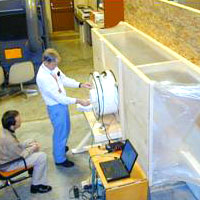Insulation
ORNL’s Thermal Insulation and Buildings Materials Research for Next-Generation Buildings

ORNL provides state-of-the-art buildings envelope research through internationally recognized experts using modern test facilities at the Buildings Technology Center (BTC), a DOE National User Facility. Accomplishments to date have been numerous, yet the need for ongoing research in this area continues, since space heating, cooling, and ventilation account for 35% of energy consumption for buildings (29% for commercial and 41% for residential). In a recent study of deployment of energy-efficient technologies in commercial buildings, more than $1.5 billion annually was saved from use of three such technologies alone. In addition, energy-efficiency innovations in home building have resulted in substantial efficiency improvements over the last 20 years. Nevertheless, homes built in the last 10 years consume more energy than those built in the previous three decades, resulting in the ongoing need to pursue energy-efficient solutions for buildings.
The buildings construction industry is notable for its slow acceptance of new technologies. The industry is highly fragmented, which contributes to the market’s resistance to adopting new technology. R&D investments represent less than 1% of sales revenues, far less than the average U.S. industry investment. As a result, DOE-funded research plays a critical role in developing technological advancements that reduce energy consumption and increase building longevity. Major ORNL accomplishments in the buildings technology arena are described below.
New Calculator and Simulation Tools
ORNL has developed an arsenal of building design and simulation tools and standards that assist practitioners—ranging from homeowners to architects— in selecting energy-efficient envelope options. Some recently developed tools include:- WUFI-ORNL – More than 2400 licensed building design professionals are using this tool to determine moisture problems, reducing callbacks and health-related problems with indoor air quality (http://www.ornl.gov/sci/btc/apps/moisture/index.html).
- ZIP-Code Calculator – This tool provides location-specific advice on insulation and moisture control to the more than 500 people who visit this site daily (http://www.ornl.gov/sci/roofs+walls/calculators/index.html).
- Roof Radiation Control Calculator – computes the potential energy savings and peak demand for various roof selections (http://www.ornl.gov/sci/roofs+walls/calculators/index.html).
- Other frequently used tools include the Air Leakage Calculator (based on research data collected from sources such as the air leakage tester pictured above), Whole-Wall Calculator, and WeatherFileAnalyzer – a unique tool that can develop the exterior hygrothermal load for any U.S. or Canadian city (http://www.ornl.gov/sci/roofs+walls/calculators/index.html).
Moisture Control and Hygrothermal Performance Studies
This research emphasizes mitigating and preventing mold, which degrades the performance of insulation and can lead to poor air quality and health problems in high-performance buildings.
- ORNL is collaborating with the city of Seattle, Washington, to assess the city’s moisture-damage problems in both current and older buildings. Key moisture-design performance issues have been investigated for three classes of wall systems. A prominent city official has indicated that ORNL provided exceptional benefits: “Considering the energy saved from preventing a roll-back in energy code standards and all of the intangible environmental, social, and economic benefits that energy efficiency represents, the State of Washington and City of Seattle are truly indebted to ORNL."
Development and Testing of Advanced Materials for Insulation and Roofs
This work focuses on developing building and roofing materials with extraordinary properties for insulation and solar radiation control.
- Insulation: ORNL has worked with several industrial partners in testing and developing foam that is blown with several non-ozone-depleting chemicals. This research has supported industry in the transition to more environmentally acceptable insulation materials for walls, roofs, refrigerators, and freezers. Quantifying performance on unbounded loose-fill attic insulations helped improve Minnesota’s energy code. The development of panel insulation offering three times the thermal resistance of insulations of similar thickness is finding applications in specialty consumer appliances, medical material protection, and defense field applications.
- Roofs: New cool-pigmented roof colors employ complex organic color pigments, termed cool roof-color materials (CRCMs), that are added to roof paints. These pigments improve thermal performance by making a dark roof reflect in the near-infrared portion of the spectrum, maintaining a lower roof temperature and reducing heat leakage. Several metal roofing manufacturers have incorporated CRCMs in new painted metal products at an additional cost of only 5 cents per square foot with a payback period of only 3 years.
Challenges and Opportunities
Research that supports the next generation of buildings includes:
- Designing advanced thermal insulation and materials technologies to support Net Zero Energy Buildings. Smart roofs and exterior walls incorporate temperature-sensitive polymers that provide an artificial surface overlaying conventional roof tiles and wall cladding and stucco. These materials provide high reflectivity to the sun’s radiation during hot seasons and low reflectivity during cool seasons. Energy savings for roofs is from 5 to 10 cents per square foot when compared with the best available roofing material.
- Developing an R-25, 4-inch wall system for on-site construction. Such a system would double the R‑value of current wall systems.
- Pursuing advanced computer modeling tools to simulate hygrothermal responses to various external climate conditions. Extended capabilities for measuring hygrothermal properties of insulation materials would be used to develop and publish a database of materials properties.
- Improving the building envelope to shave and shift peak-demand energy requirements. Such technological breakthroughs would enable building envelopes to contribute for the first time to electric reliability.
- Using advanced modeling tools to specify materials with optimum property requirements for sheathing and cladding systems and then achieving these materials through appropriate component selection.

